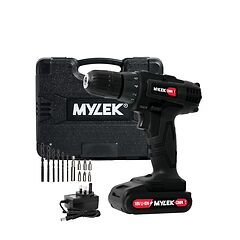
October 8th, 2020 by
When comparing cordless drills, two features that you will most commonly see on product descriptions are speed and torque, but what are they? They are often confused as different terms for the same thing but that is not the case. In fact, they have an inverse relationship.
What is the difference between speed and torque?
Speed, in terms of a drill or motor, is what you would expect it to be: the rate at which the motor spins. It is measured in terms of rotations per minute (RPM). The higher the RPM, the faster it is able to turn the drill bit. The speed is usually controlled by the trigger on the drill: the harder you squeeze the trigger, the faster it will turn. This is obviously something that you adjust as you use the drill.
Torque is force. It is the amount of rotating force that the motor develops. It is measured in terms of newton-metres (N-m). Torque is controlled by a clutch, which is the range of numbers (usually from 1 to 10, 20, or even 30) on the collar of the drill. This is something you set prior to starting to drill.
MYLEK Black 18V Li-ion Cordless Drill 2 Speed MYCBMC
Price: £43.00
Buy Now
The inverse relationship of speed and torque
Not only are speed and torque different things, but they are also inversely proportional. In simple terms, this means that the more speed you apply, the less torque you will get, and vice versa. To get slightly more technical, the torque is supplied by the current. Increasing the speed also increases the back electromotive force (back EMF or counter EMF) which blocks incoming current, thereby lowering torque.
Which is better? Torque or speed?
If you are using torque and speed capabilities as a comparative measure to choose a new cordless drill, it’s really not as simple as saying one is better than the other as a generalisation because it largely depends on the type of task you wish to use it for.
The most appropriate settings will usually be determined by the material you wish to drill into as it’s about striking the right balance between the two. A softer material, such as wood or plaster, requires more speed but less torque as too much force could cause the material to split or fracture. Harder material, such as metal and brick, needs more torque but less speed to be able to get through it.
Most people, when choosing a cordless drill for their home DIY projects, will be seeking a general all-round tool that they can use for a range of applications. Understanding the balance between torque and speed and knowing how to adjust it according to the task in hand is therefore as important as the drill itself. A drill that offers a range of settings in both these areas could offer maximum flexibility in its use on a range of applications, so long as used in the right way.
Comments
Leave a reply
Your e-mail address will not be published. All fields are required



